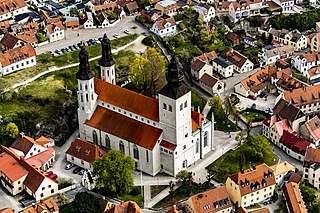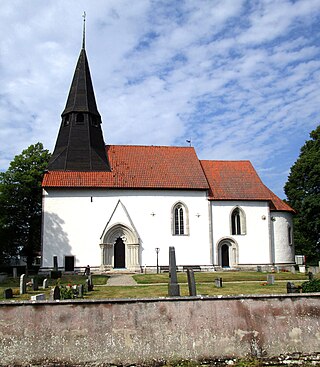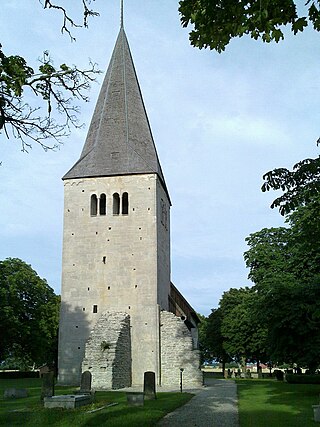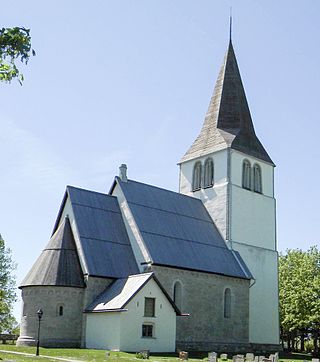
Visby is an urban area in Sweden and the seat of Gotland Municipality in Gotland County on the island of Gotland with 24,330 inhabitants as of 2017. Visby is also the episcopal see for the Diocese of Visby. The Hanseatic city of Visby is arguably the best-preserved medieval city in Scandinavia, and, since 1995, it has been on the UNESCO World Heritage Site list. Among the most notable historical remains are the 3.4 km (2.1 mi) long town wall that encircles the town center, and a number of church ruins. The decline as a Hanseatic city in the Late Middle Ages was the cause for many stone houses being preserved in their original medieval style.

Gotland, also historically spelled Gottland or Gothland, is Sweden's largest island. It is also a province/county, municipality, and diocese. The province includes the islands of Fårö and Gotska Sandön to the north, as well as the Karlsö Islands to the west. The population is 61,023 (2024) of which about 23,600 live in Visby, the main town. Outside Visby, there are minor settlements and a mainly rural population. The island of Gotland and the other areas of the province of Gotland make up less than one percent of Sweden's total land area. The county formed by the archipelago is the second smallest by area and is the least populated in Sweden. In spite of the small size due to its narrow width, the driving distance between the furthermost points of the populated islands is about 170 kilometres (110 mi).

The Diocese of Visby is a division of the Church of Sweden consisting of the island of Gotland. Its seat is Visby Cathedral located in the largest town on Gotland, Visby.

Vibble is a locality in Västerhejde on the Swedish island of Gotland. Sweden with 1,300 inhabitants in 2010. Situated 3 km (1.9 mi) south of Visby, it is sometimes regarded as a suburb to the town of Visby. The main business in Vibble is tourism. The relocated original Villa Villekulla - where Pippi Longstocking lived - is at the Kneippbyn Holiday Resort in Vibble.

Visby Cathedral, formally Visby Saint Mary's Cathedral, is a cathedral within the Church of Sweden, seat of the Bishop of Visby. It lies in the centre of Visby, the main town on the Swedish island Gotland. It was built as the church of the German traders in the city during the 13th century. The first church was probably a wooden church, which was later replaced by a stone building. Originally built as a basilica, it was successively expanded and rebuilt during the Middle Ages. At the end of this period it had been transformed to a hall church, which it still is. In 1361, Gotland and the church became part of Denmark. Following the Reformation, it was the only medieval church in the city left in use, and in 1572 raised to the status of cathedral. Since 1645 Gotland and the cathedral have been part of Sweden. A major renovation was carried out in 1899–1903 under the guidance of architect Axel Haig.

Bunge Church is a medieval church in Bunge on the Swedish island of Gotland. The church seen today was largely built during the 14th century and is in a High Gothic style typical for churches on Gotland. Inside, the church is richly decorated with medieval murals, including depictions of medieval knights whose significance remain contested. Bunge Church belongs to the Church of Sweden and lies in the Diocese of Visby (Sweden).

Hejdeby Church is a medieval church in Hejdeby on the Swedish island of Gotland. The church was built in stages during the 13th century, and contains medieval murals from two different periods. Hejdeby Church is part of the Diocese of Visby within the Church of Sweden.

Ala Church is a medieval church in Ala on the Swedish island of Gotland. Its oldest parts date from the 12th century. Damaged by fire in the 1930s, it still contains medieval murals and its original baptismal font. The church belongs to the Church of Sweden and lies within the Diocese of Visby.

Alskog Church is a medieval church in Alskog on the Swedish island of Gotland. The church in its entirety dates from the 13th century, with the last additions probably being made c. 1300. A few alterations are of later date. It contains several medieval furnishings, as well as some medieval stained glass windows. Alskog Church belongs to the Church of Sweden and lies in the Diocese of Visby.

Anga Church is a 13th century church in Anga on the Swedish island of Gotland. It is one of the most well-preserved Romanesque churches on Gotland, and was possibly preceded by a stave church. Inside, the church is decorated with medieval murals from three different periods, as well as some medieval furnishings. Some wooden sculptures from the church are today exhibited in a museum in Visby. The church belongs to the Church of Sweden and lies within the Diocese of Visby.

Alva Church is a medieval church in Alva on the Swedish island of Gotland. The oldest parts of the church date from the late 12th century; with the halted construction of the tower about a century later, building activity ceased. The church contains medieval murals as well as a number of medieval furnishings and pieces of art. It lies in the Diocese of Visby of the Church of Sweden.

Ardre Church is a medieval church in Ardre on the Swedish island of Gotland. It was built during the 13th century, but the interior re-decorated in 1900–1902 after plans by artist Axel Haig. Several of the furnishings of the church are medieval. The church is in the Diocese of Visby of the Church of Sweden.

Atlingbo Church is a medieval church in Atlingbo on the Swedish island Gotland. Atlingbo Church was built in stages during the 13th century, with only the sacristy being of later date. The church contains a decorated Romanesque baptismal font made by the workshop or sculptor known as Byzantios. It is used by the Church of Sweden and lies in the Diocese of Visby.

Akebäck Church is a medieval church in Akebäck on the island of Gotland, Sweden. It's a largely Romanesque church and its main construction period was at the end of the 12th century. The church is part of the Diocese of Visby within the Church of Sweden.

Follingbo Church is a medieval church in Follingbo on the Swedish island of Gotland. Its Romanesque nave and tower are noteworthy for the professionalism with which they were built. It lies in the Diocese of Visby and is used of the Church of Sweden.

Björke Church is a medieval church in Björke on the Swedish island of Gotland, in the Diocese of Visby.

Levide Church is a medieval church on the Swedish island of Gotland. It lies in the Diocese of Visby.

Terra Nova Church Swedish: Terra Nova kyrkan is a church in Visby, on the Swedish island Gotland. The church was designed by Hans Wieland and was inaugurated in 1983. It was inaugurated by Bishop Tore Furberg.




















